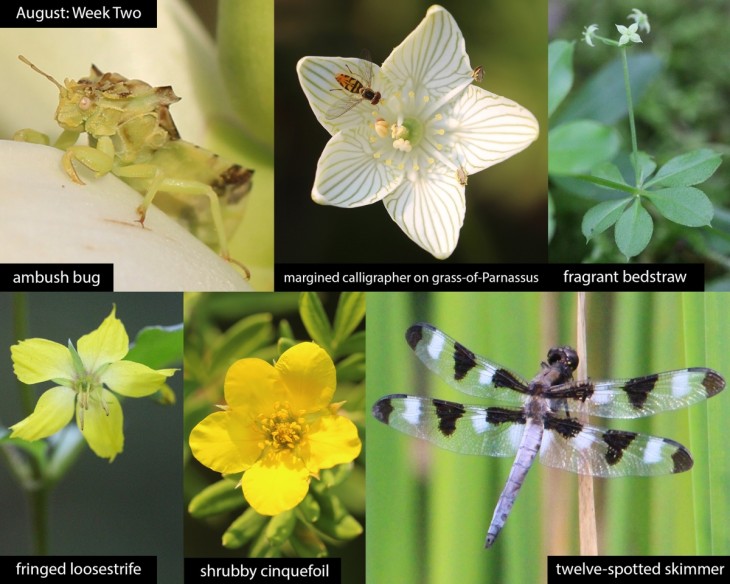This week in the woods, an ambush bug perched in patient silence, eyes bulging, as it awaited prey atop a white turtlehead blooming in Corinth, Vermont. Like little Nosferatus of late-summer meadows, ambush bugs lie in wait to attack and drain other insects often many times their size. When an ambush bug encounters a fly, bee, wasp, butterfly, or moth hoping to nectar on its hunting ground, it reaches out with scythe-like forelegs, pierces a vulnerable spot with its hollow beak, and injects paralyzing agents and digestive enzymes. It can then hoover the liquified insides from its immobilized prey and leave an empty husk. You might have some trouble finding one of these innovative predators for the same reasons they can so effectively surprise their quarry: their diminutive size, tendency to nestle among vegetation, and ability to match their varied colorations to a wide variety of flowering plants. However, if you see an unusually unmoving nectaring insect dangling in a vertical position, you may discover an ambush bug gripping it by its neck and sucking out its innards. (For more on this captivating species, see these Outside Story articles by Ted Levin and Steven Shepard.)
Nearby, Ann Little photographed this grass-of-Parnassus, now at peak bloom. Also known as bog star or marsh, fen, or northern grass-of-Parnassus, and in fact a forb rather than a grass, this plant sends up a single, ivory-white, five-petaled, cup-shaped flower on a long, straight, clear stem. Multiple tactics attract pollinators like this margined calligrapher and guide them to the bog star’s nectar reward: a honey-like scent, a roadmap of green veins on its five petals, and whorls of sterile stamens (in addition to the five others) that glisten like drops of nectar. This plant is native to North America, from Alaska to Arizona and over to us in the Northeast, but also to Europe and Asia; the ancient Greek naturalist Dioscorides observed similar plants in meadows on Mount Parnassus and saw the cattle there favoring them as forage.
On the margins of the same wetland, fringed loosestrife showed off its star-shaped flowers and hairy-stalked leaves. Like the yellow loosestrife discussed last month, this Lysimachia plant is native to North America and unrelated to the invasive purple loosestrife. Unlike the majority of flowers that offer nectar as a reward to visitors, fringed loosestrife tempts pollinators with oil. Some bee species can add the oil to food for their larvae or line their nests with it for waterproofing. Both grass-of-Parnassus and fringed loosestrife have obligate bee species, which cannot survive or reproduce without their host plant: The parnassia miner lays its egg on a loaf made exclusively from the nectar and pollen of the grass-of-Parnassus, and the common loosestrife oil bee provisions its nests with oil and pollen only from fringed loosestrife.
It might surprise hikers who have encountered shrubby cinquefoil in dry montane sites to see the same plant in a wet, lowland habitat, but it grows equally well in both sets of conditions. Its dainty foliage and flowers, flaky bark, and adaptability to pruning make this shrub a suitable species for bonsai. It also goes by the names golden hardhack and potentilla.
Fragrant bedstraw may inspire you to crouch down in the duff to admire its tiny pale-green flowers. Comparably worthy of admiration are its whorls of elliptical, pointed leaves growing along sprawling stalks. Later in the season, if you get your face down even further, you might take in a vanilla scent – presumably lovely for those who used to stuff their mattresses with the dried leaves.
With as many as 200 species represented in Vermont and New Hampshire, dragonflies can cause some identification struggles, but the twelve-spotted skimmer makes for a good place to start – large, with telltale twelve brown wing spots, and a habit of assuming prominent perches. The males, like this one, also have an additional ten white spots; when they age, they may develop a waxy or frosty blue powder seen here called pruinescence (also a familiar sight on plums, grapes, succulents, and certain mushrooms). As Michael J. Caduto explains in this Outside Story article, dragonflies can serve as important indicators of water quality. However, twelve-spotted skimmers have a particular tolerance for pollution. One of only a handful of New England’s migrating dragonfly species, they have already begun their southward autumn migration; the individuals that return next spring will belong to a new generation.
What have you noticed in the woods this week? Submit a recent photo for possible inclusion in our monthly online Reader Photo Gallery.


